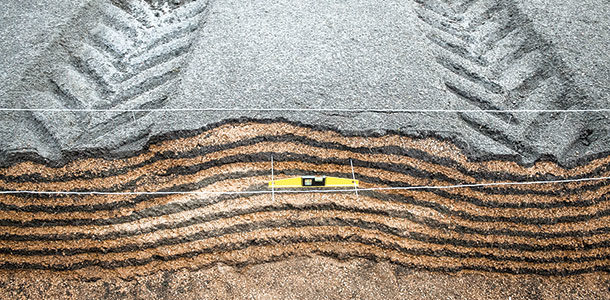Tractors, combines, sprayers, manure spreaders and other ag equipment have all increased in size in recent years. When heavy equipment compresses the soil, the result can be restricted root growth, poor nutrient intake and stunted plant development, all of which can lead to lost yield – up to 60 percent based on some research.
Environmental quality is also at stake, since hard, compacted soil can cause moisture runoff and soil erosion.
The good news, however, is that forage growers can take proactive steps to manage the risk by being aware of the factors that cause compaction and learning how to minimize it.
The primary cause is contact pressure, which is exerted by the pressure of tires on the soil surface. Numerous studies have shown the benefits of increased flexion (IF) and very high flexion (VF) tires that can operate at a lower air pressure under increased loads, compared to standard radial tire technology.
Think about walking across a field of snow. Wearing snowshoes creates a larger footprint, helping to prevent you from sinking down into the snow.
Similarly, increased flexion in agricultural tires allows for a larger tire footprint to help spread out the weight of the machine, which decreases soil compaction.
Today’s latest tire technologies enable farmers to carry a heavier load at the same air pressure compared to standard radial technology or the same load at a lower pressure.
In addition, a larger tire footprint allows for better traction in the field, less slippage and improved fuel economy. Better traction and transfer of power to the ground also improves tire life and machine performance.
Tests conducted and demonstrated at the 2014 Farm Progress Show in Boone, Iowa, compared VF tire technology to standard radial tires. One demonstration illustrated the difference in footprint between the two tire designs on identical tractors. The VF tire provided nearly 100 square inches more contact with the ground. A traction test was also conducted in which less slippage with the lower-pressure VF tires resulted in a fuel savings of up to 20 percent compared to standard technology radial tires.
Tires versus tracks
A common question is: Which causes more compaction, tires or tracks? Much of the research reveals no significant difference. A study at Ohio State University suggests that tire air pressure is a determining factor. In that study, a 310 hp tractor with overinflated dual tires (24 psi) was compared to a 350 hp tractor equipped with properly inflated duals (6 psi).
The tractor with overinflated duals caused the most compaction, and the least compaction if operated with proper tire inflation pressure.
As reported in a 2014 Penn State Extension report, this study showed that “duals can do as good a job in avoiding topsoil compaction as tracks, provided the tire pressure is kept low.”
Axle load – defined as the total weight supported by each axle – is another major contributor to compaction. Higher axle loads cause greater compaction, especially down into the subsoil, which is a critical area for storing moisture and supporting deep root growth.
The Penn State Extension report states that deep subsoil compaction is permanent and should be avoided at all costs – specifically, by keeping axle loads below 10 tons and preferably below 6 tons.
Another form of compaction is sidewall compaction, which can occur during planting in wet ground, causing the planting furrow wall to be compacted. As reported by the University of Kentucky Extension, plant roots can push through the mud if the ground stays moist.
But if planting is followed by dry weather, the walls can harden, causing most root growth to occur in the planting furrows instead of the rest of the soil. Corn plants, for example, may look normal at emergence but begin to show nutrient deficiency and drought stress after the plants are several inches high.
Preventing compaction
The best way to protect the soil and maximize crop production is to prevent compaction as much as possible. Here are recommended steps producers can take:
- Compaction is greatest in wet soil, since driving on it causes slippage, ruts and deep compression. If possible, delay field work for a few days to allow the ground to dry longer since drier soil is better able to withstand high axle loads and tire pressure.
However, there may be an economic trade-off to take into consideration since delays in planting or harvesting might have more significant consequences than compaction.
- As noted, decreasing axle load and using tires that can operate at lower air pressure are two of the most important ways to reduce compaction.
Utilize equipment that is as light as possible for your operation yet still efficient in transferring horsepower to the ground without slippage.
- Use radial rather than bias tires and duals to replace singles to further distribute machine weight. Larger-diameter tires can help increase the length of the footprint to decrease tire contact pressure.
- Where possible, minimize the number of trips over the field and reduce the area of your field that is touched by equipment.
- Controlled traffic is also an effective way to manage compaction. This involves limiting heavy machinery to the same lanes through the field each season.
The lanes become compacted, but machinery is not operated on the soil between the lanes. This is a very common practice in Europe and has been proven to increase yield by minimizing compaction.
Protecting the soil is one of the best investments farmers can make in maximizing crop performance and yield potential. While it may not be possible to avoid compaction entirely, it can be successfully managed with the right equipment and proper management practices. FG
References omitted due to space but are available upon request. Click here to email an editor.

- James Crouch
- Farm Segment Marketing Manager
- Michelin North America











